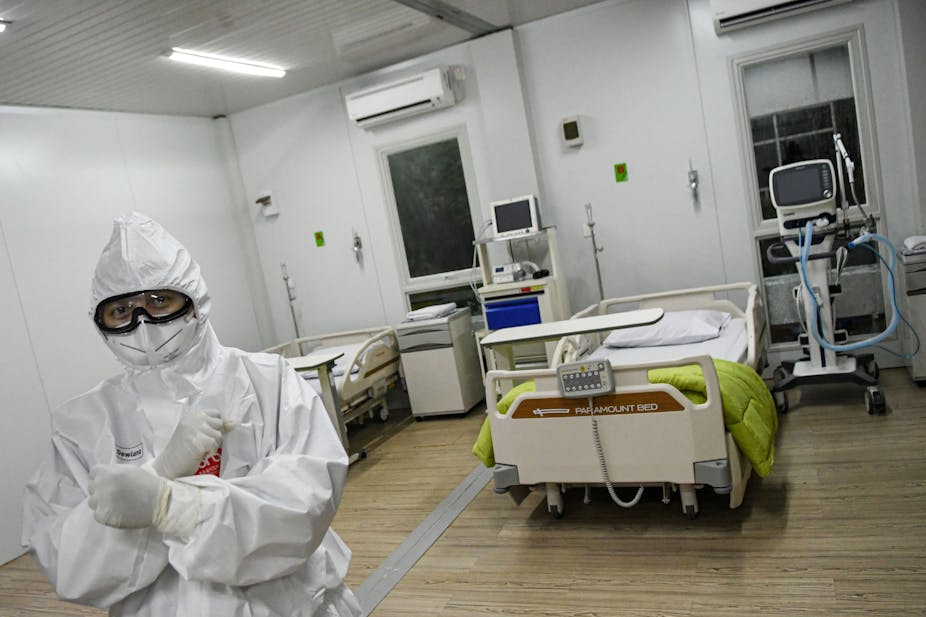The COVID-19 pandemic has severely affected the healthcare sector in Southeast Asia’s largest economy, Indonesia. One of the most devastating effects is a high infection and mortality rate among healthcare workers.
The latest data from the Indonesian Medical Association showed at least 718 healthcare workers have died due to COVID-19 infections, including 325 doctors and 324 nurses.
These figures are among the highest in the world. What makes this even more alarming is Indonesia has relatively low numbers of healthcare practitioners – only four doctors and 21 nurses per 10,000 citizens. For comparison, Malaysia has 15 doctors and 35 nurses, and Singapore 23 doctors and 62 nurses per 10,000 citizens.
Our recent research reveals that significant discrepancies in the quantity and quality of hospitals’ facilities and services for COVID-19 treatment have increased risks for medical workers.
The main cause of such discrepancies is significant variations in the adequacy of hospital finances.
The research
We studied 11 hospitals in various parts of Indonesia, including Northern Sumatra, Central Java, Eastern Java and Bali. Five were COVID-19 referral hospitals. We noticed, however, that with the number of infections surging, many non-referral hospitals have also had to treat COVID-19 patients.

As part of their occupational health and safety (OHS) policies, all studied hospitals have established and provided policies, procedures, mechanisms and equipment for handling COVID-19 infections to ensure the safety and well-being of healthcare staff.
The infection and prevention control (IPC) units’ main task is to handle infectious diseases in hospitals. These units supervise implementation of the COVID-19 safety procedures.
The IPC units develop preventive, treatment and rehabilitative procedures for doctors, nurses, patients and families to follow. They also ensure compliance with COVID-19 protocols.

Our research found significant discrepancies among hospitals, both referral and non-referral, in terms of the quantity and quality of their facilities and equipment.
Our field observation found not all hospitals have special isolation rooms (SIR) and intensive care units (ICUs) equipped with negative air pressure – an important feature to prevent the spread of the virus.
Some hospitals do not have enough ventilators and do not adequately test patients for the coronavirus.
Due to the limited number of facilities for treating COVID-19 patients, some hospitals fail to carefully assess patients’ condition and allocate them to inappropriate rooms for treatment.
It is also concerning that some hospitals could not provide enough of the required personal protective equipment (PPE) of the right quality.
Our interviews with doctors and health workers reveal they sometimes must wear substandard PPE or use their equipment for prolonged periods despite it must be replaced regularly to ensure hygiene. Some doctors told us they even have to buy the PPE themselves because their hospital does not provide it.
All these situations would increase healthcare workers’ potential exposure to the virus, increasing their health risk or financial burden.
These issues have resulted in physical and psychological harm to healthcare workers and, critically, have also resulted in some of them transmitting the virus.
The failures to follow safety protocols
Each hospital has set up safety protocols for COVID-19 treatment, included in the OHS guidance. However, we found significant discrepancies in the levels of awareness and commitment of healthcare staff in adhering to the protocols.
One key source of healthcare worker infection in hospitals is the use of various shared facilities for staff, such as changing rooms, dining rooms (where staff often eat together in enclosed spaces), prayer rooms, lifts and bathrooms.
There are also indications that non-clinical workers may perceive their risk of contracting and transmitting the virus as low. The result is less careful adherence to infection control practices.
The findings indicate a large portion of the infections among healthcare workers, ironically, occur outside the workplace, where workers drop their guard against the virus.
The impacts on medical workers
Our study also found many healthcare workers experienced mental problems and increased physical workload.
This confirms study findings reported by the Faculty of Medicine at the University of Indonesia, showing 83% of Indonesian health workers suffered from burnout syndrome or stress due to fatigue at work. This was especially the case in hospitals with limited availability of staff.

Mental burdens are higher because they face patients infected by the coronavirus and the trauma of witnessing deaths among patients and associates.
Society’s attitudes, resulting in negative stigma, do healthcare workers no favours. Many believe these workers are likely to contract the virus due to their interaction with COVID-19 patients.
As a result, many healthcare workers feel isolated as some people tend to avoid social interactions with them and their families.
This research was funded by the Australian Government through the Australia-Indonesia Centre under the PAIR program
The Australia Indonesia Centre supports The Conversation Indonesia in the production of this article.


